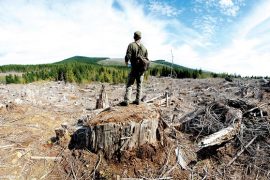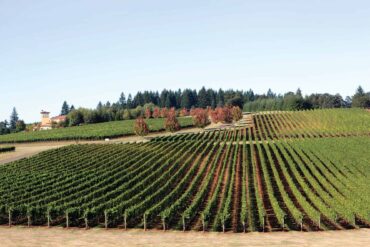The Skyline Forest is a 33,000-acre tree farm west of Bend that was once owned by timber company Crown Pacific. In 2003, Crown Pacific filed for bankruptcy, and its assets went to its creditors. Ownership of Skyline Forest fell to Fidelity National Financial of Jacksonville, Florida and its subsidiary, Fidelity National Timber Resources. The dissolution of Crown Pacific and its use as timber lands led to a struggle with many stakeholders. The plot’s owner, Fidelity, seeks legislation that would change Skyline Forest’s land use to accommodate residential units. Nonprofit Central Oregon LandWatch fought to restrict the use of the land and the number of residential units. In May 2009, Oregon legislators asked Fidelity, Central Oregon LandWatch and the Deschutes Land Trust to negotiate a deal that would create incentives for the landowner to limit the footprint of their development. Those negotiations ended in HB 2228, which the Legislature passed in June of that year. That bill allowed Fidelity National Timber Resources to build 282 dwellings on a small portion of the forest if it agreed to sell the remaining acreage to Deschutes Land Trust. Citing insufficient time to research the economics that drove the original bill, Fidelity, after the bill’s passage, sought to change the terms of it with more residential units. Today, the situation remains at an impasse.
Paul Dewey
Executive Director
Central Oregon
LandWatch
For more than ten years Central Oregon LandWatch has fought efforts by developers to build homes on private timberland known as the Skyline Forest, nestled between Bend, Sisters and the Three Sisters mountains. Fundamental to Oregon’s land-use system is the concept that houses should not be scattered across the landscape, especially in our forests and other natural areas.
Now, we have the owner, Fidelity National Financial, seeking to substantially alter the legal framework that has helped make Oregon the most livable place in the nation. Even worse, this Florida corporation is breaking an agreement it made before the Oregon Legislature just two years ago.
In 2007, the 33,000 acre Skyline Forest was identified by the Oregon Legislature as a potential community forest. In 2009, various interested parties, including both Fidelity and LandWatch, engaged in intensive negotiations to craft legislation to govern the Skyline Forest. Finally, a deal was struck. Fidelity would be allowed to build up to 282 houses (far more than would otherwise be permitted) in a 3,000-acre corner of the land. In exchange, Fidelity would sell the remaining 30,000 acres to the Deschutes Basin Land Trust, where the land would remain undeveloped and would serve the interests of the local communities.
Fidelity now wants to triple the number of houses it can build, to around 800 dwellings. This intensive development would harm critical wildlife habitat in the Tumalo deer winter range. It would dramatically increase the difficulty in providing community services, such as fire protection in this high fire risk area, deep in our forest. And it represents a fundamental breach of the agreement the parties reached in good faith just two years ago. The Oregon Legislature should summarily reject Fidelity’s new overreaching proposal, and the parties should focus on efforts to implement the existing Skyline Forest legislation to preserve this important area.
Greg Lane
President
Fidelity National
Timber Resources
People working together has made Oregon a leader in preserving forestland. The key is to find innovative solutions—alternatives that move away from us vs. them, to a win-win vision. That approach is critical to the success of the Skyline Community Forest.
Before we bought the 33,000 acres, it was being divided and sold piecemeal for development. We ended that practice and agreed to work with the Deschutes Land Trust and the State to preserve 30,000 acres as a Community Forest. In return, we would transfer our development rights to a 1,200-acre sustainable development area. That approach is part of our larger strategy of finding economically viable ways of conserving forestland. For example, we have a track record of successfully partnering with The Conservation Fund and the State to provide the land for the Gilchrist State Forest.
In 2009, a variation of the Skyline Forest proposal was added to a bill without our input. Without supporting economic data, the bill arbitrarily established a formula allowing 282 homes within the 1,200 acres. In case the formula was wrong, we negotiated a provision to make the proposal optional rather than mandatory.
Since then, economic studies have shown the real costs. The number of homes needed to make the project work is closer to 750. Therefore, we propose to revise the legislation to allow more homes on smaller lots. Our revisions will actually reduce the size of the development to 1,000 acres. The other 30,000-plus acres will become the community forest.
Skyline Community Forest can be a win-win. With the revised unit count, it will allow enough homes to make the project work economically and will preserve more forestland forever.
In contrast, a bill that doesn’t work for both sides will only lead to forest fragmentation. We’re committed to meeting both environmental and economic concerns by making Skyline Community Forest a reality.









